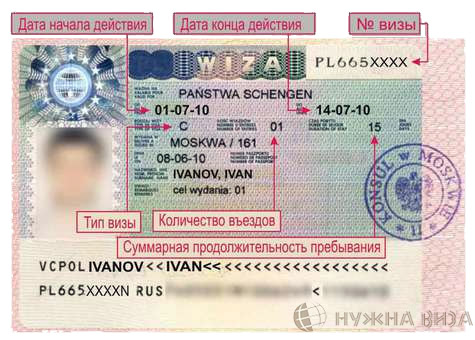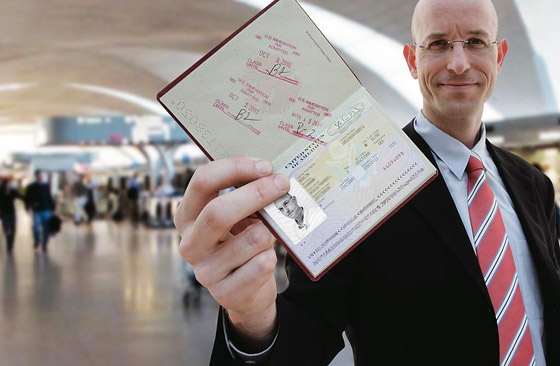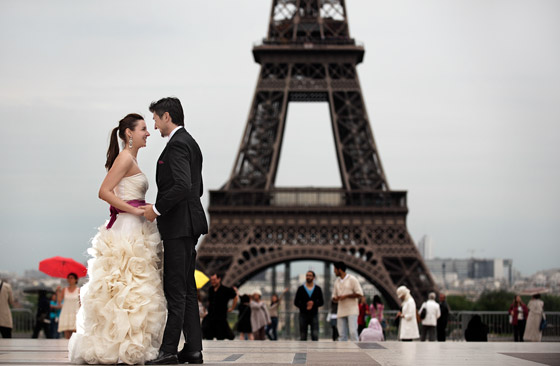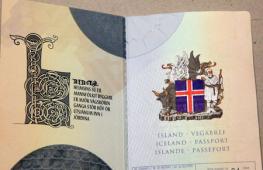What types of visas are classification and generally accepted designations
In most cases, a special permission from the authorities will need to visit another state. A formal confirmation of such permission is a visa that the appropriate embassy issues. This practice was introduced after World War II as a means of control over the movements of foreign citizens. If at the beginning of the visa had a sufficiently divided nature in terms of design and differed only on the entrance and exit, now they have already undergone significant changes. They became not only mandatory for visiting many states, but also began to be divided into categories.
Different types of visas are determined not only the fact of obtaining permission to visit the country, but also the purpose of the visit, restrictions on the term of stay, restriction on the subject of permitted activities and the importation of means and goods. You can get a visa at the embassy of the state where the trip is scheduled, and so quickly, as styling the internal rules of embassies.
The visa is not required only if there are appropriate agreements between countries, such as residents of countries that have signed the Schengen Agreement, any movements between the participants of the contract can be freely without the need for visas. For all other entries, the Schengen zone is allowed on the general rules specified by the Schengen Agreement.
In each country, the world visas are divided into categories or noted by alphanumeric labeling and are intended for a specific type of visiting. For example, in there are three types, which are issued for labor activity: H-1B, H-2A, N-2B.
At the moment, all types of resolving documents can be divided into two main groups: short-term and long-term. Each of these groups additionally clarify by several more subcategories. Short-term maybe such:
- Tourist;
- Guest;
- Business;
- Transit.
Long-term are divided into:
- Guest;
- Working;
- Student;
- For reunion of the family or moving to permanent residence (immigration).
In addition, the type may vary depending on the status of the recipient, so distinguish: a simple visa, service and diplomatic.

- And - airport;
- In transit;
- C - tourist;
- D - National.
Already on the basis of these types, the numeric code details are indicated, for example, D-14 is a long-term national visa for learning.
Valid term of a visa. Single and multivis
Any visa is issued with a limited validity period and gives the right to be in the country only a certain time. The method of visiting may be additionally negotiated. So almost all types of visas can be one-time and multiple (multivisas). With one-time, everything is extremely simple, they are designed for a single visit. Leaving the country even ahead of time, there is no longer possible to cross the border again without the design of a new visa. Multiple visas limit only the total time of stay and do not interfere with the regular border crossing. Most often, the Multi mark is put on the document itself.
When calculating the time of staying in the country with a visa regime, the entire time period is taken into account from the moment of crossing the border when arrival and before the actual departure. In the Schengen zone, the countdown of stay begins after the intersection of the first border of any member country, respectively register and departure.
Short-term visas
The short-term are all types of visas that are issued with a permission to visit the country from 1 to 90 days. These include transit, tourist, guest and business visas. Sometimes it is possible to extend the period, while it is required or contact the immigration service, or visit one of the border checkpoints to obtain the corresponding mark in a foreign passport. However, by the condition of issuing a short-term visa, the visitor must lean the territory of the state no later than the specified deadlines.
Tourist
The most common type of visas designed to visit the country as a tourist, rest or visiting the places of interest or events. A number of restrictions are superimposed on it. With a tourist visa in hand, it is impossible to hire a job or start learning, to conduct research or scientific activities, which can affect the interests of the country visited or if such activities require individual permits. Actually, any activity other than tourism is prohibited. Restrictions on the importation and export of cash or some goods are superimposed. All conditions can be clarified in the consulate upon receipt or their information sources. Such visas are issued more often for the period of staying from 15 to 90 days, rarely more. Most likely, in the process of obtaining, you will need to specify the accurate route, stops, the exact time of arrival and departure from the destination country.
In the case of the European Union, the types of Schengen visas for tourism belong to the category "C". Subcategories from 1 to 4 indicate the period of which stay in Schengen:
- C1 for a period not exceeding 30 days;
- C2 for a period of 31-90 days;
- C3 multivisa with a total length of stay up to 90 days;
- C4 multi for 90 days and with a period of up to 5 years.
For the US, a regular tourist visa has the designation B-2.
Guest
The process of registration of a visa can be significantly simplified if there is an invitation from a resident of the country where the trip is scheduled, and it will already be classified as guest. Such a short-term visa allows you to visit many countries without the necessary formalities, such as booking rooms in hotels or indicating the exact route.
![]()
It is important to take into account all the necessary formalities presented by the consulate for the invitation, if this requires a visa procedure. Guest viszes in various countries may have many subcategories depending on the guest's inviting and maintenance conditions.
Business
Business visa implies a country visit to negotiate or conclude contracts, search for new partners, etc. Such permits are issued to either legal entities or official representatives of firms or companies. At the same time, an invitation from the host should be obtained, that is, the companies with which meetings are planned, or an official letter from the relevant authorities, such as the Chamber of Commerce, indicating the scope of the applicant.
You can visit Schengen to conduct business negotiations both with a visa category with and the corresponding type and category D if the activity is limited only to one of the countries of the Schengen Agreement.
Even if the case concerns the state in which tourist visits or strict rules of registration are actually prohibited, it is quite simple to obtain a business visa, especially if the visitor's activity field meets internal and foreign policy.
Transit
To visit many corners of the planet, you need to additionally cross the territory of third countries. It may be a brief stop of the aircraft for refueling or the route of ground transport, laid through the territory of the third country between the point of departure and the purpose of the trip. Some countries are allowed to be foreign citizens located in the airport or other buffer zone without any additional formalities during such stops or routes. And yet, more often, it will be necessary, in addition to obtaining a visa to the country of destination, also to take care of the receipt of transit visas of countries whose boundaries will have to cross along the way. The process of obtaining is extremely simple and consists of frequently in informing representative offices on transit. Issued on the fact of the availability of permission to visit the target state and confirming the documents of the tracking path.
Long-term visas
All long-term visas are permission to stay over 91 days, up to several years. You can only get a long-term visa with a sufficient justification of the purpose of the visit and in the event that they do not contradict the established rules. As an example, guest visas can be distinguished for visits to relatives for a long period, work visas, permits for adoption of training in schools, colleges, universities.
Guest
The long-term guest visa most often implies a visit to relatives or close families for a period up to several years. At the same time, an invitation is required and, if necessary, a sufficient justification and confirmation of related links between the inviting party and the invitation.
In the Schengen zone as a guest long-term can perform a visa having type D. It confirms permission to visit a separate country in the Schengen zone, therefore it is also defined as national. In most cases, it will still be attended by other countries of the Schengen Agreement, while only one important rule remains - the country of the first entrance to the Schengen zone with such a visa should be exactly the one for which it is issued.
Working
For official registration of hired labor abroad, it is necessary to get a working visa. Such a visa is a residence permit for the entire validity of the employment contract or agreement. Without a difference, be it to attract a highly qualified professional or seasonal handyman to obtain such a visa requires an invitation from the company in which the invited one intends to work. Only with the intention of finding a job should provide a letter from the local Chamber of Commerce or confirmation of vocational guidance and experience that are in demand in the target region.

Almost always distinguish work visas in the nature of labor employment. For example, in the case of a Schengen zone, they may relate to the three main categories regarding the rules:
- D-15 - is issued to conduct professional activities or to work on demanding positions;
- D-07 - seasonal work in agriculture.
In other countries, working visas may differ, given the situation in the labor market.
Student
For the passage of training in foreign universities, students and students are drawn up with a student or training visa, allowing to stay on the territory of the country the entire period of training and in some cases, as with a multivide, repeatedly cross the border. To obtain, confirmation documents are defined, indicating that the educational institution is ready to adopt a foreign student. The validity period of the visa can cover the entire period of training or only part of it, for example one semester. In the second case, it will be necessary to constantly extend the action of the permission subject to the absence of the claims of the university to the student.
On a row with training visas, you can get a guest, designed to support the student by parents or his visiting while he is studying.
Reunion of the family and moving to a permanent place of residence
A separate type of visa in many countries is permission to reunite families. The conditions for obtaining such a visa differ significantly from the state to the state and depend on the peculiarities of mentality, customs and even religion. It makes it possible to be visiting relatives for a long time, up to several years or to be the starting point for the family of a family of uniform citizenship.
To obtain such a visa, it is necessary to justify a related communication and confirm the desire of the received parties to place and it is possible to contain the applicant.
Other types of visa
In addition to such visas, as a tourist, working or guest, there are additional subcategories that arise as a result of the need to clearly limit the rules of staying in the country or point to the special status of the visit.
Visa for marriage. Bride's visa
International marriages require a special approach. One of the main objectives of such unions is to obtain uniform citizenship for all family members. In order to ensure the conditions for obtaining citizenship by the bride and groom, permits are drawn up, that is, a visa for marriage. The permit is more often called the visa of the bride, because much more often the bride moves to the bride and must subsequently obtain new citizenship. A similar visa is often much more complicated than a simple guest, in addition to the invitation, seemingly convincing evidence of a close connection between future spouses, excluding a fictitious marriage option. This situation has developed with the process of obtaining a visa K1 for the United States.

On the other hand, in some countries, such as a visa with a number 300 (wedding visa) is somewhat lighter, because this country is loyal to international marriage and supports such unions. It is difficult at the same time a citizen (citizen) of Australia, because it will be necessary to prove its financial consistency for the content within two years of its second half.
Journalist
To implement a journalist activity in other countries, it is also necessary to issue an appropriate visa. In the US, the category "I" is issued to representatives of the media with severe conditions of the journalism of activity and coverage of information. In addition to the United States, the journalistic visa will need to be issued when departing to Cuba, Iran, North Korea, the Kingdom of Saudi Arabia and Zimbabwe. In most of the other countries, the entry of media representatives can be carried out on a simplified scheme or at all as a visa-free mode.
Service and diplomatic
Hotel Category visas is provided for representatives of countries and organizations that have official and diplomatic passports. In such cases, the process of registration of permits is performed at the level of the relevant governing bodies.
Visas for research and scientific activities
Almost all countries having a visa regime are provided for certain categories of resolving documents for those who want to conduct research or scientific activities in the state. Most often, such visas are obtained in a simplified procedure. For example, in South Korea, a visa for researchers and researchers can be issued within a few hours online through the embassy portal.
Anyway Before applying for registration, you should definitely indicate the reason for visiting the country with a visa regimeAfter all, it was on the basis of the statement that the consulate will be made on choosing the appropriate type of visa. Together with the receipt of the required permission, it is necessary to additionally clarify all the nuances regarding the restrictions and requirements operating in the planned country for visitors. This applies to issues of import and export of money, goods, items, and even the behavior of the permissible according to customs and mentality. Violation of the visa regime may entail a ban for re-visiting.



